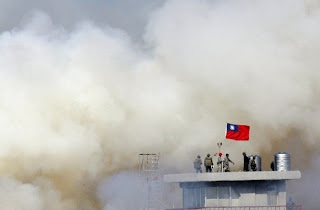 The latest computerized scenario carried out by the military showed that in a war with China, Taipei would be occupied by enemy forces in just three days, a magazine report said yesterday.
The latest computerized scenario carried out by the military showed that in a war with China, Taipei would be occupied by enemy forces in just three days, a magazine report said yesterday.Last month’s simulation, attended by President Ma Ying-jeou (馬英九), came amid warnings that China was expected to increase the number of its missiles aimed at Taiwan by several hundred to more than 1,900 by the end of this year. These include ballistic missiles, cruise missiles and other weaponry deployed throughout China.
Under the scenario, which assumed war at next year’s force levels, the People’s Liberation Army (PLA) launched intensive air raids on Taiwan before sending in ground troops from the sea and air, the Chinese-language Next Magazine reported.
The drill found that Chinese troops could march into Taipei on the third day of hostilities, seizing control of top military command facilities and the Presidential Office, Next said, quoting unnamed sources.
The results were a severe blow to Ma’s goal of building “solid defense and efficient deterrence” with a small but elite army, the magazine said.
During his presidential campaign, Ma vowed to build a stronger military as a deterrent against aggression by Beijing. Under Ma’s plan, Taipei has worked to achieve an all-volunteer force, but this will come at great cost to the defense budget, which is set at US$9.3 billion this year, a 6.9 percent drop from last year’s US$9.6 billion and US$10.5 billion in 2008.
The military must also cope with a number of aging defense systems that are due for refurbishing or replacement, including its F-16A/B fighter aircraft.
The Ministry of National Defense dismissed Next’s report.
This article, published today in the Taipei Times, continues here.

No comments:
Post a Comment